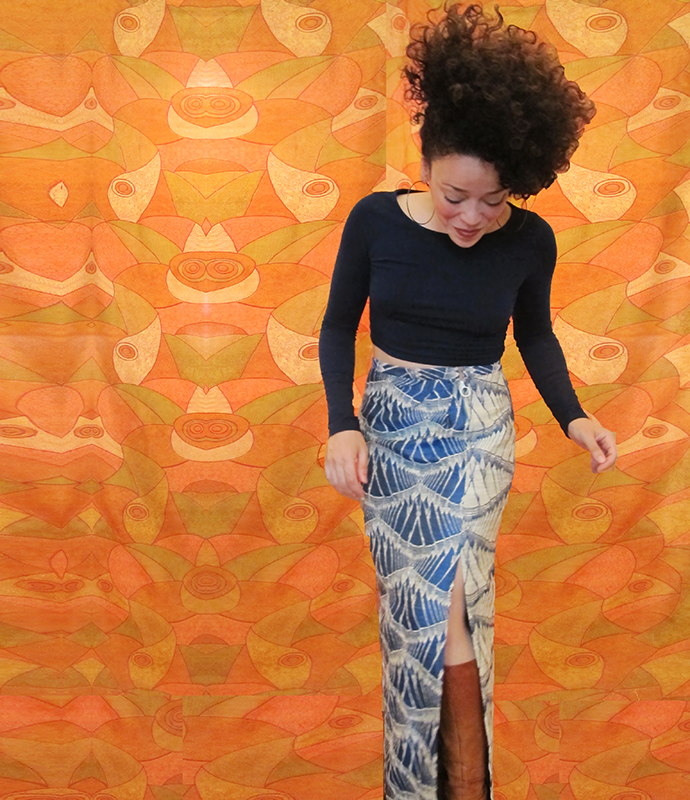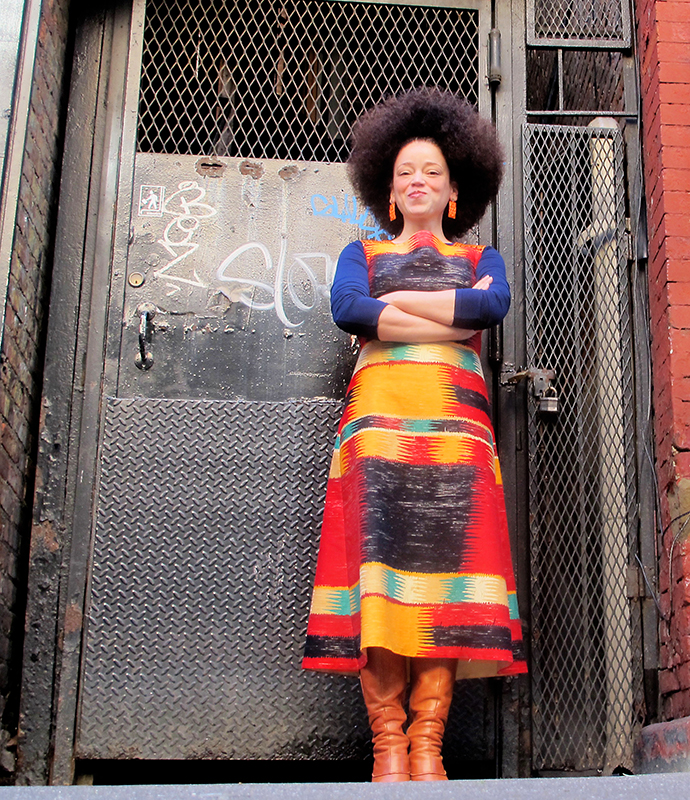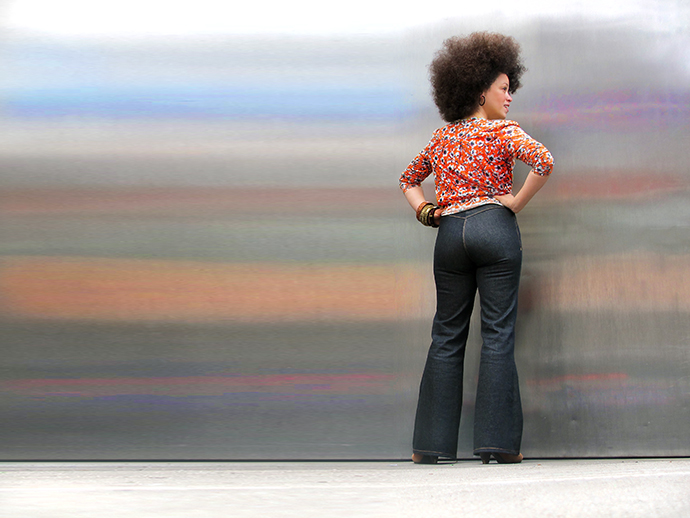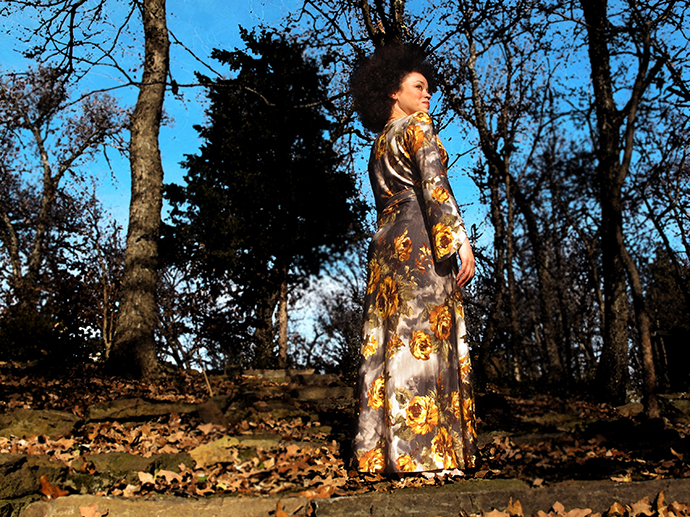
So, this skirt is currently up over at The Mood Sewing Network, and really, you must see the horror show that is the side seams. Well, you know the drill, civilians wearing RTW wouldn't bat an eye at it, but we are HIGHLY TRAINED PROFESSIONALS.
RTW, by the way, stands for Ready To Wear. The stuff you buy in Forever 21, and the like. I mention it because I've had several emails lately asking what TNT stands for, and it reminded me that there are many things you learn along the way, and once you learn them, you sort of go OH! DUH! and assume that you were the last one to catch on. So I thought I'd do a little stream of consciousness-- things that I know, that I think are common knowledge, things that I wish I knew when I started, things that I'll get up on my soapbox about. Shorties love soapboxes.
1. What the Hell Does That Stand For.
TNT: Tried 'n True. Any pattern that you've tried, and, well, it's true. You've made it, and can make it again without any more fitting or worrying. RS, WS: right side, wrong side of fabric. CB, CF: center back, center front. L/S line: lengthen/shorten. FBA: Full bust adjustment (not happening 'round here). UFO: Unfinished object (happening most of the time 'round here). GSOH: Good sense of humor. Essential for sewing. SA: seam allowance. OOH! SEAM ALLOWANCE!
1. Patterns without Seam Allowances Are Kind of AWESOME.
I know. I know you HATE to add SA to a pattern after you've already angrily traced it, possibly after ragefully PRINTING it, but guys. An MIA SA is a good thing. First, if you're going the couture route, you'll have the seamlines already marked and ready to trace onto your fabric or muslin. Second, you can hack and change a pattern so much easier when you can already see where the seamline should be. Third, you can add the proper SA for the treatment you want to use, instead of wasting fabric on extra seam allowance that you maybe don't need. Want to use your serger for those seams? 1/4 SA. Know that this pattern is going to fit you well? 3/8 SA. Fitting as you go, and want some extra insurance? 1 inch SA. Hrmmmmm. That said...
2. Too Much Seam Allowance Can F With Your Head.
For real. Home sewists are an anomaly in our use of wider seam allowances. Of course, a lot of commercial patterns come with that big old 5/8ths included, so sometimes you can't escape it. But it's so much easier to use the edge of your presser foot as a guide, and, if you think about your presser foot...it doesn't extend to 5/8ths. Sure, there's all sorts of handy markings on your needle plate, but try sewing a 3/8s (or 1cm) seam with the needle offset, using the edge of the foot as your guide. Then try it with the needle in the center position, using the plate marking as your guide. Then come back and tell me which one was easier (and bring some gin with you, we're almost out. I love my gin like I love my seam ripper).
3. Yes, I Love My Seam Ripper. Cause Stitches be TRIPPIN'.
You are not a newbie, or unskilled, or going to the third level of hell, because you had to use your seam ripper. I have five different kinds of seam rippers, and use them CONSTANTLY. They are your friend. Think of them like the coal that turns your work into diamonds. (Coal actually has zero to do with diamonds. But you catch my drift.)
4. Measure Twice, Cut Once.
Same as the carpenter's golden rule: Measure yourself, like all the time! And then cut carefully. If you're careful in your measuring and cutting, your results will show for it. And while you're at it...
5. Pins Will Cut You.
No, they won't. They'll stick you, and cause you to wonder what those scratches are all over your torso, but they won't cut you. They can, however, cause problems in cutting. I used to cut out everything with the pattern pinned to the fabric, using lots and lots of pins, because more is more. What I was actually doing was upsetting how the pattern laid on the fabric, as those pins simply can't lie flat. And those little ridges created by the pins add up! Pattern weights are your friend, and you don't have to go all ninja on it. Thin books, small plates, a smartphone, they do the trick too.
6. BUT PINS WILL CUT YOU.
As mentioned previously, no they won't. But they might eventually end your beloved machine's life if you sew over them. This is a hot topic, with sewists planting their feet firmly on one side or the other, but having ended Ricky's life during a frantic race over pins during Project Sewn, I'm headmaster of camp PINS WILL CUT YOU. Even if you're going slow, that's metal on metal. Think of the grinding. THE METALLIC GRINDING. No bueno, yo.
7. Let Your Thread Be Your Pilot.
Thread! It is so useful! A bit of fiber, magically keeping us un-naked! When you read directions like, Understitch, or Stay Stitch, and you think, PAH! I'm not wasting my thread! Listen, yo. WASTE YOUR THREAD OR WASTE YOUR GARMENT. The two techniques I just mentioned will change your sewing, and I know from experience, because I avoided those steps like Jury Duty the first year I started sewing. When I finally decided to slow down and include those techniques, it was like a revelation. Curves didn't stretch out, linings turned to the proper side, angels sang a mixtape of 80s power ballads. And yeah, sometimes you'll unpick a small spool's worth of thread on a project-- but your hem is going to fall under your iron ever so much easier when there's a nice long line of basting stitches, helping the fabric to fold evenly. Which brings me to...
8. Iron. Iron. Iron.
I have always loved pressing and ironing, right from the get-go. My Nan taught me how to iron, so maybe that's why. When I hear people grumbling about pressing while sewing, I truly don't understand-- to me, it's magical to see those seams lying flat and bending to my steamy will! Curves taking shape around a ham! MAGIC RIGHT ON MY IKEA IRONING BOARD! If you don't love ironing, maybe it's your iron. This is my favorite. Speaking of love...
9. Love The Patterns That Love YOU Back.
I fell prey to so much oooo I love that on her! when I started. On top of considering what looks good on your particular hot bod, consider that different pattern companies use different fit models and blocks to create their patterns. And maybe they don't have your brand of hot bod in mind. If you have to make seventy gajillion adjustments to a pattern, it might not be the company for you. Sure, there are very few patterns that fit right out of the envelope, but you might start to see that some companies are more your cup of joe.
Just because a pattern looks good on someone else, and they had success with it, doesn't mean it will work for you. That isn't necessarily the fault of the pattern (and it sure isn't the fault of the sistergirl wearing it).
10. Blame it On The Boogie.
Or, on the sistergirl you're reading. Did someone tell you to use magnets to trace a pattern? That someone is probably drinking something questionable, and should not be trusted. There oughta be a law.
11. Learn The Rules So You Can Break Them
Now, this is one I should have employed all along, but, see: #7. My first vocal teacher drilled it into my head: Learn the music as written, and then you can embellish and backphrase and whatnot. After all, how are you going to properly break a rule if you don't understand the very rule you're breaking? And let's face it. BREAKING RULES IS FUN. USING RULES IS FUN. IN FACT
12. EVERYTHING ABOUT SEWING SHOULD BE FUN.
Whether you're just starting out, and merrily skipping all the rules, or employing every technique there is in the book, it's all useful. It's all learning. So have fun and do it. It all adds to your 10,000 hours. I don't regret the bad pattern choices I made, the poorly inserted zippers, the questionable libations. (Well, I do regret Jagermeister.)
Well, that's just off the top of my head. I said this is "A Sewist's Dozen," so I invite y'all to be number 13 in the comments! I know that there are newbies out there, who are at the same place many of us were, who'd appreciate the knowledge, even if it seems rudimentary to us! (Hell, just last month, I asked how to use the L/S line on the Baste & Gather FB group. Lost my mind briefly. Because, Jeans.) So please, share away!
RTW, by the way, stands for Ready To Wear. The stuff you buy in Forever 21, and the like. I mention it because I've had several emails lately asking what TNT stands for, and it reminded me that there are many things you learn along the way, and once you learn them, you sort of go OH! DUH! and assume that you were the last one to catch on. So I thought I'd do a little stream of consciousness-- things that I know, that I think are common knowledge, things that I wish I knew when I started, things that I'll get up on my soapbox about. Shorties love soapboxes.
1. What the Hell Does That Stand For.
TNT: Tried 'n True. Any pattern that you've tried, and, well, it's true. You've made it, and can make it again without any more fitting or worrying. RS, WS: right side, wrong side of fabric. CB, CF: center back, center front. L/S line: lengthen/shorten. FBA: Full bust adjustment (not happening 'round here). UFO: Unfinished object (happening most of the time 'round here). GSOH: Good sense of humor. Essential for sewing. SA: seam allowance. OOH! SEAM ALLOWANCE!
1. Patterns without Seam Allowances Are Kind of AWESOME.
I know. I know you HATE to add SA to a pattern after you've already angrily traced it, possibly after ragefully PRINTING it, but guys. An MIA SA is a good thing. First, if you're going the couture route, you'll have the seamlines already marked and ready to trace onto your fabric or muslin. Second, you can hack and change a pattern so much easier when you can already see where the seamline should be. Third, you can add the proper SA for the treatment you want to use, instead of wasting fabric on extra seam allowance that you maybe don't need. Want to use your serger for those seams? 1/4 SA. Know that this pattern is going to fit you well? 3/8 SA. Fitting as you go, and want some extra insurance? 1 inch SA. Hrmmmmm. That said...
2. Too Much Seam Allowance Can F With Your Head.
For real. Home sewists are an anomaly in our use of wider seam allowances. Of course, a lot of commercial patterns come with that big old 5/8ths included, so sometimes you can't escape it. But it's so much easier to use the edge of your presser foot as a guide, and, if you think about your presser foot...it doesn't extend to 5/8ths. Sure, there's all sorts of handy markings on your needle plate, but try sewing a 3/8s (or 1cm) seam with the needle offset, using the edge of the foot as your guide. Then try it with the needle in the center position, using the plate marking as your guide. Then come back and tell me which one was easier (and bring some gin with you, we're almost out. I love my gin like I love my seam ripper).
3. Yes, I Love My Seam Ripper. Cause Stitches be TRIPPIN'.
You are not a newbie, or unskilled, or going to the third level of hell, because you had to use your seam ripper. I have five different kinds of seam rippers, and use them CONSTANTLY. They are your friend. Think of them like the coal that turns your work into diamonds. (Coal actually has zero to do with diamonds. But you catch my drift.)
4. Measure Twice, Cut Once.
Same as the carpenter's golden rule: Measure yourself, like all the time! And then cut carefully. If you're careful in your measuring and cutting, your results will show for it. And while you're at it...
5. Pins Will Cut You.
No, they won't. They'll stick you, and cause you to wonder what those scratches are all over your torso, but they won't cut you. They can, however, cause problems in cutting. I used to cut out everything with the pattern pinned to the fabric, using lots and lots of pins, because more is more. What I was actually doing was upsetting how the pattern laid on the fabric, as those pins simply can't lie flat. And those little ridges created by the pins add up! Pattern weights are your friend, and you don't have to go all ninja on it. Thin books, small plates, a smartphone, they do the trick too.
6. BUT PINS WILL CUT YOU.
As mentioned previously, no they won't. But they might eventually end your beloved machine's life if you sew over them. This is a hot topic, with sewists planting their feet firmly on one side or the other, but having ended Ricky's life during a frantic race over pins during Project Sewn, I'm headmaster of camp PINS WILL CUT YOU. Even if you're going slow, that's metal on metal. Think of the grinding. THE METALLIC GRINDING. No bueno, yo.
7. Let Your Thread Be Your Pilot.
Thread! It is so useful! A bit of fiber, magically keeping us un-naked! When you read directions like, Understitch, or Stay Stitch, and you think, PAH! I'm not wasting my thread! Listen, yo. WASTE YOUR THREAD OR WASTE YOUR GARMENT. The two techniques I just mentioned will change your sewing, and I know from experience, because I avoided those steps like Jury Duty the first year I started sewing. When I finally decided to slow down and include those techniques, it was like a revelation. Curves didn't stretch out, linings turned to the proper side, angels sang a mixtape of 80s power ballads. And yeah, sometimes you'll unpick a small spool's worth of thread on a project-- but your hem is going to fall under your iron ever so much easier when there's a nice long line of basting stitches, helping the fabric to fold evenly. Which brings me to...
8. Iron. Iron. Iron.
I have always loved pressing and ironing, right from the get-go. My Nan taught me how to iron, so maybe that's why. When I hear people grumbling about pressing while sewing, I truly don't understand-- to me, it's magical to see those seams lying flat and bending to my steamy will! Curves taking shape around a ham! MAGIC RIGHT ON MY IKEA IRONING BOARD! If you don't love ironing, maybe it's your iron. This is my favorite. Speaking of love...
9. Love The Patterns That Love YOU Back.
I fell prey to so much oooo I love that on her! when I started. On top of considering what looks good on your particular hot bod, consider that different pattern companies use different fit models and blocks to create their patterns. And maybe they don't have your brand of hot bod in mind. If you have to make seventy gajillion adjustments to a pattern, it might not be the company for you. Sure, there are very few patterns that fit right out of the envelope, but you might start to see that some companies are more your cup of joe.
Just because a pattern looks good on someone else, and they had success with it, doesn't mean it will work for you. That isn't necessarily the fault of the pattern (and it sure isn't the fault of the sistergirl wearing it).
10. Blame it On The Boogie.
Or, on the sistergirl you're reading. Did someone tell you to use magnets to trace a pattern? That someone is probably drinking something questionable, and should not be trusted. There oughta be a law.
11. Learn The Rules So You Can Break Them
Now, this is one I should have employed all along, but, see: #7. My first vocal teacher drilled it into my head: Learn the music as written, and then you can embellish and backphrase and whatnot. After all, how are you going to properly break a rule if you don't understand the very rule you're breaking? And let's face it. BREAKING RULES IS FUN. USING RULES IS FUN. IN FACT
12. EVERYTHING ABOUT SEWING SHOULD BE FUN.
Whether you're just starting out, and merrily skipping all the rules, or employing every technique there is in the book, it's all useful. It's all learning. So have fun and do it. It all adds to your 10,000 hours. I don't regret the bad pattern choices I made, the poorly inserted zippers, the questionable libations. (Well, I do regret Jagermeister.)
Well, that's just off the top of my head. I said this is "A Sewist's Dozen," so I invite y'all to be number 13 in the comments! I know that there are newbies out there, who are at the same place many of us were, who'd appreciate the knowledge, even if it seems rudimentary to us! (Hell, just last month, I asked how to use the L/S line on the Baste & Gather FB group. Lost my mind briefly. Because, Jeans.) So please, share away!





























